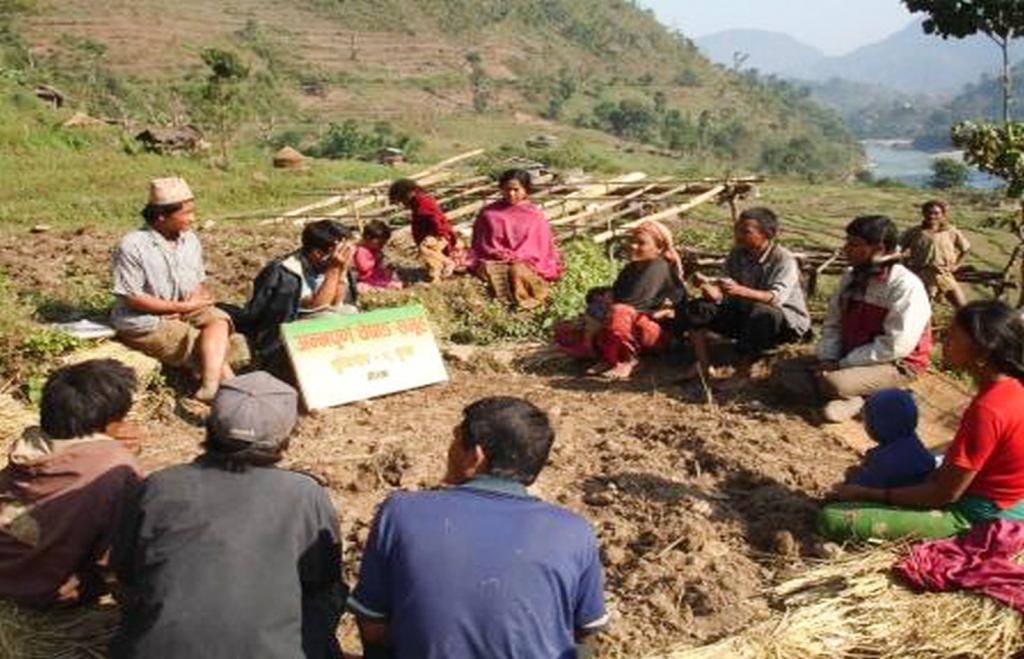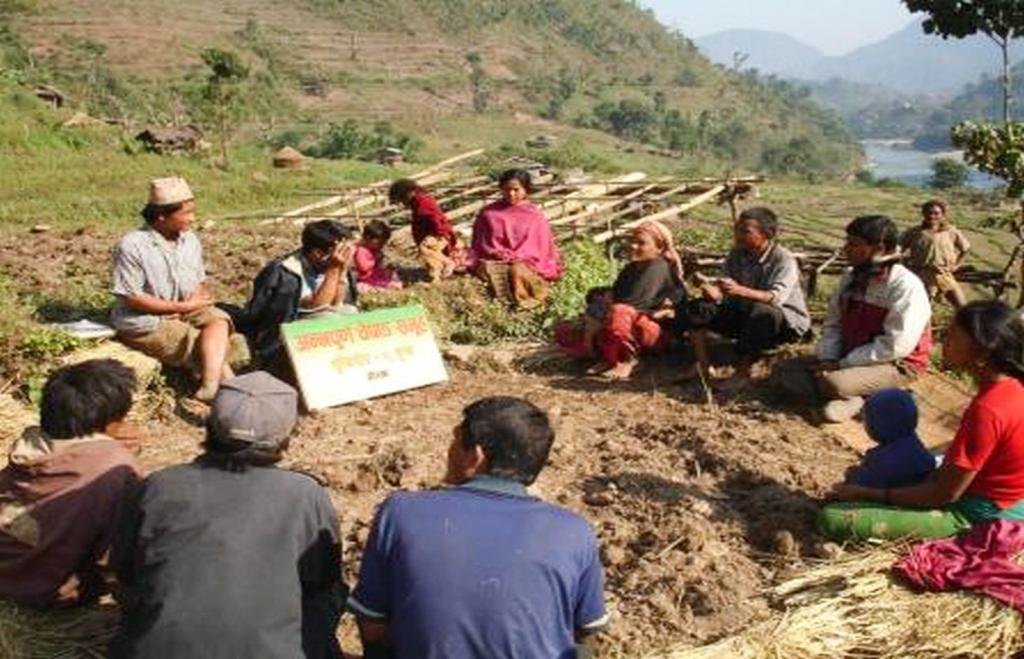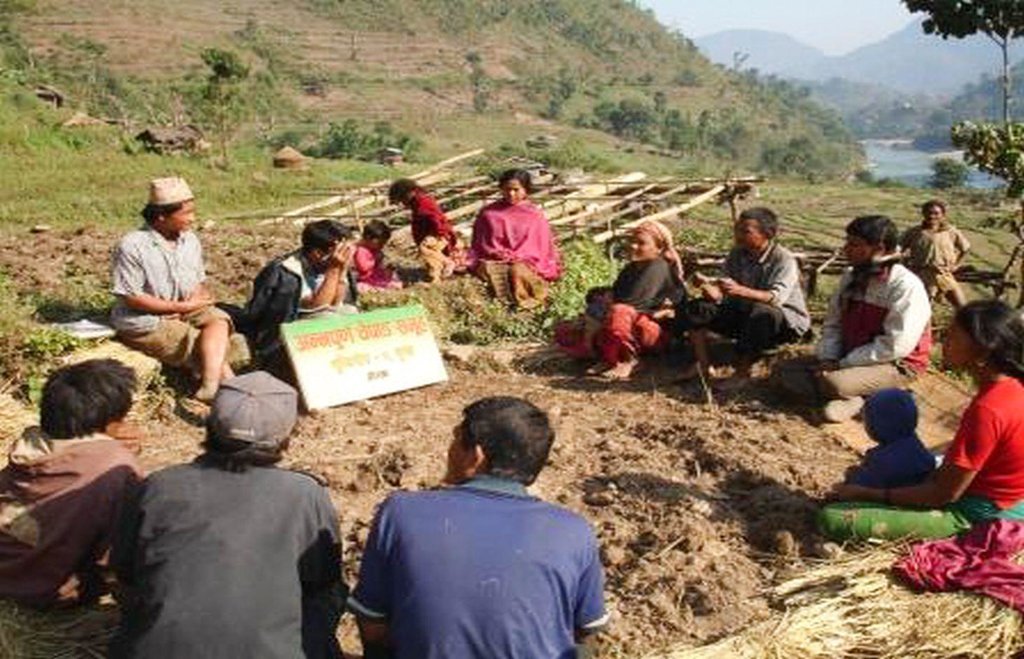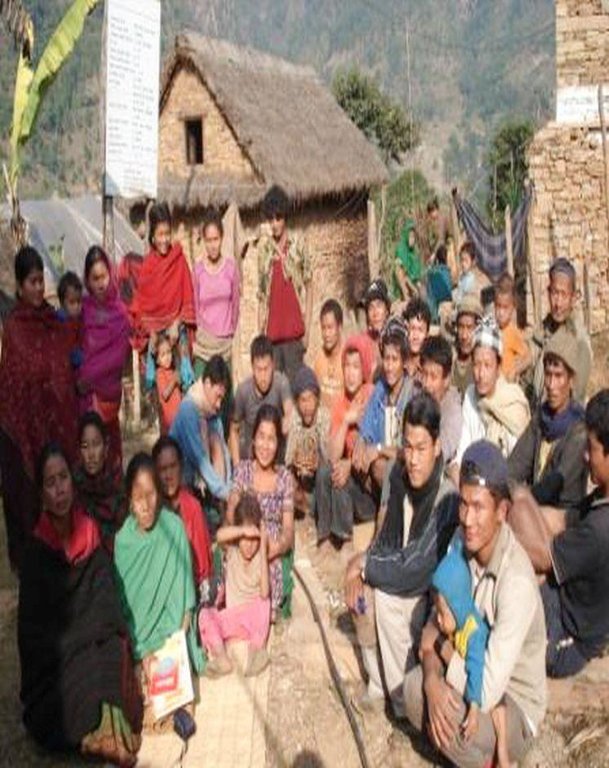Sharing labour to implement contour bunding [Nepal]
- Creation:
- Update:
- Compiler: Shreedip Sigdel
- Editor: –
- Reviewer: Fabian Ottiger
Janasakti aadanpradhan gari bhajo halne padhiti karanwanan (Main contributor: Bir Bahadur Tamang, LI-BIRD)
approaches_2604 - Nepal
View sections
Expand all Collapse all1. General information
1.2 Contact details of resource persons and institutions involved in the assessment and documentation of the Approach
Key resource person(s)
SLM specialist:
SLM specialist:
Tamanag Bir Bahadur
+977 61 526834 (0); 9746005992 (M)
btamang@libird.org
LI-BIRD, Gairapatan, Pokhara, P.O. Box 324
Nepal
1.3 Conditions regarding the use of data documented through WOCAT
When were the data compiled (in the field)?
01/03/2013
The compiler and key resource person(s) accept the conditions regarding the use of data documented through WOCAT:
Yes
2. Description of the SLM Approach
2.1 Short description of the Approach
Members of a community can work together to help prevent soil erosion and increase productivity by working collectively to establish contour bunds.
2.2 Detailed description of the Approach
Detailed description of the Approach:
Aims / objectives: Over generations, the ethnic minorities of Nepal, who practice fireless shifting cultivation, known as 'gujultyaune', have successfully used contour bunding to control soil erosion, promote water retention, and increase crop production. Contour bunding is a proven sustainable land management practice in areas where the soil productivity of marginal, sloping, and hilly lands is very low. While it is both low cost and simple to implement, it does have the drawback that establishing contour bunds is very labour intensive. When members of a community work together to establish contour bunds the whole village can benefit.
Methods: By working collectively, a community can establish contour bunds that will benefit everyone and not individual farmers alone. The first step is to plan a course of action and to select the sites. Members of the community, who are thoroughly familiar with the landscape that the community inhabits, get together to discuss where the contour bunding will be most successful and benefit the greatest number of farmers. This planning phase is best carried out during the dry season before the rains begin. Once the sites are selected, everyone participates in the slashing of materials on the shifting cultivation lands. After the slashed materials have been allowed to dry for some weeks, the community assembles to gather these into rows that will form the bunds. Every member of the community participates according to their ability.
Stages of implementation: The steps for sharing labour to establish contour bunds in a community which practises shifting cultivation can be summarized as follows:
• The community meets to finalize a plan of action.
• Everyone participates in the slashing of shifting cultivation plots.
• The slashed materials are collected and allowed to dry.
• The slashed materials are formed into rows that will constitute the bunds.
• Everyone participates and eventually, the land between the bunds is prepared for the cultivation of crops.
2.3 Photos of the Approach
2.5 Country/ region/ locations where the Approach has been applied
Country:
Nepal
Further specification of location:
Tanahun, Gorkha District
2.7 Type of Approach
- traditional/ indigenous
2.8 Main aims/ objectives of the Approach
The Approach focused mainly on SLM with other activities (increasing crop production)
To increase crop yields and help to prevent soil erosion in communities that practise shifting cultivation by getting the whole community to participate in establishing contour bunds.
The SLM Approach addressed the following problems: The main stumbling blocks to this approach are a gap in the sharing of traditional knowledge, lack of the money needed for investment, community conflicts over allocation of resources, and overall poor social cohesiveness.
2.9 Conditions enabling or hindering implementation of the Technology/ Technologies applied under the Approach
availability/ access to financial resources and services
- hindering
Individual farmers do not have sufficient resources to
implement the technology on their own
Treatment through the SLM Approach: By sharing labour everyone benefits without any outlay by individual farmers
institutional setting
- hindering
Groups are not aware of how to mobilize for community empowerment
Treatment through the SLM Approach: Raise level of awareness and enhance capacity on how to mobilize the community and on how to institutionalize the process
knowledge about SLM, access to technical support
- hindering
Traditional knowledge on contour bunding is not shared
Treatment through the SLM Approach: Technical information is shared when the technology is implemented
3. Participation and roles of stakeholders involved
3.1 Stakeholders involved in the Approach and their roles
- local land users/ local communities
This technology is straightforward; the community of land users can implement it without external input. This is a sustainable land management practice in areas where shifting cultivation is practised. These areas have typically been inhabited by poor and marginal groups like the Chepang, Magar, Dalit, and Gurung groups.
3.2 Involvement of local land users/ local communities in the different phases of the Approach
| Involvement of local land users/ local communities | Specify who was involved and describe activities | |
|---|---|---|
| initiation/ motivation | self-mobilization | Demand created by the community |
| planning | interactive | Through discussions the whole community is involved in deciding what sites are to be contoured and how the bunding technology is to be implemented. |
| implementation | self-mobilization | The whole community is involved in planning the sites, slashing the biomass, and forming the contour bunds. |
| monitoring/ evaluation | none | |
| Research | none |
3.3 Flow chart (if available)
Description:
Each household (HH) contributes labour and the community works together to implement contour bunding.
Author:
AK Thaku
3.4 Decision-making on the selection of SLM Technology/ Technologies
Specify who decided on the selection of the Technology/ Technologies to be implemented:
- land users alone (self-initiative)
Explain:
The land users themselves decide on the technology during participatory discussions held in the community. This is a bottom-up approach
Decisions on the method of implementing the SLM Technology were made by by land users* alone (self-initiative / bottom-up). The land users themselves possess traditional knowledge on how the technology should be implemented. Since some farmers have a better grasp of the technology than others, the different methods are discussed and the community as a whole decides what method is to be used.
4. Technical support, capacity building, and knowledge management
4.1 Capacity building/ training
Was training provided to land users/ other stakeholders?
Yes
Specify who was trained:
- land users
Form of training:
- farmer-to-farmer
- demonstration areas
- public meetings
4.2 Advisory service
Do land users have access to an advisory service?
Yes
4.3 Institution strengthening (organizational development)
Have institutions been established or strengthened through the Approach?
- no
4.4 Monitoring and evaluation
Is monitoring and evaluation part of the Approach?
Yes
Comments:
bio-physical aspects were regular monitored by land users through measurements; indicators: Land users regularly monitor the organic matter and moisture content of the soil and establish plants in bunds
technical aspects were regular monitored by land users through measurements; indicators: Land users regularly monitor terrace formation and soil erosion
socio-cultural aspects were regular monitored by land users through observations; indicators: The community observes and comments on the degree to which contour bunding is implemented
economic / production aspects were regular monitored by land users through measurements; indicators: Land users note crop production and how it affects their cash income
area treated aspects were regular monitored by land users through measurements; indicators: Land users regularly monitor small patches used in shifting cultivation
no. of land users involved aspects were regular monitored by land users through observations; indicators: The whole community participates in observing how many people are involved
management of Approach aspects were regular monitored by land users through measurements; indicators: The whole community participates
There were few changes in the Approach as a result of monitoring and evaluation: Gradually, farmers in other communities are also adopting the same approach
5. Financing and external material support
5.1 Annual budget for the SLM component of the Approach
If precise annual budget is not known, indicate range:
- < 2,000
Comments (e.g. main sources of funding/ major donors):
Approach costs were met by the following donors: national non-government (LI-BIRD): 20.0%; local community / land user(s): 80.0%
5.2 Financial/ material support provided to land users
Did land users receive financial/ material support for implementing the Technology/ Technologies?
No
5.4 Credit
Was credit provided under the Approach for SLM activities?
No
6. Impact analysis and concluding statements
6.1 Impacts of the Approach
Did the Approach help land users to implement and maintain SLM Technologies?
- No
- Yes, little
- Yes, moderately
- Yes, greatly
The approach was a good way of improving sloping land management.
Did the Approach empower socially and economically disadvantaged groups?
- No
- Yes, little
- Yes, moderately
- Yes, greatly
Moderate improvements were noted in Chepang, Magar, and Dalit households who benefited from this approach and improved their livelihoods
Did other land users / projects adopt the Approach?
- No
- Yes, little
- Yes, moderately
- Yes, greatly
Those who implemented this approach cited improved soil fertility and the increased productivity of cash crops like legumes as a plus point.
Did the Approach lead to improved livelihoods / human well-being?
- No
- Yes, little
- Yes, moderately
- Yes, greatly
these were mainly due to the increased earnings from the production of cash crops. Earnings were invested on daily needs which improved livelihoods.
Did the Approach help to alleviate poverty?
- No
- Yes, little
- Yes, moderately
- Yes, greatly
Some poverty alleviation was noted among households who could increase the amount that they earned from cash crops. These households used the additional earnings on health care and education.
6.2 Main motivation of land users to implement SLM
6.3 Sustainability of Approach activities
Can the land users sustain what has been implemented through the Approach (without external support)?
- yes
If yes, describe how:
This is a community-based approach; each community formulates its own rules and regulations.
6.4 Strengths/ advantages of the Approach
| Strengths/ advantages/ opportunities in the compiler’s or other key resource person’s view |
|---|
| Effectiveness (How to sustain/ enhance this strength: Improve the approach by continuing to work together to design, plan, and implement.) |
| Increases social cohesiveness (How to sustain/ enhance this strength: Continue to work collaboratively) |
| Decreased workload (How to sustain/ enhance this strength: Over time, the group decisions that work best no longer need to be revisited and less time is spent in discussions.) |
| Quick implementation of sloping land management measures (How to sustain/ enhance this strength: As the group learns to work together they can taking advantage of their synergy to quickly implement new measures.) |
| Empowerment (How to sustain/ enhance this strength: Encourage the community with technical backstopping) |
6.5 Weaknesses/ disadvantages of the Approach and ways of overcoming them
| Weaknesses/ disadvantages/ risks in the compiler’s or other key resource person’s view | How can they be overcome? |
|---|---|
| Some members contribute more than others | Each member of the group needs to be made aware of how they can contribute. |
7. References and links
7.1 Methods/ sources of information
- field visits, field surveys
- interviews with land users
7.2 References to available publications
Title, author, year, ISBN:
Indigenous knowledge of farmers in the shifting cultivation areas of Western Nepal, Regmi, BR; Aryal, KP; Subedi, A; Shrestha, PK; Tamang, BB (2001)
Links and modules
Expand all Collapse allLinks
No links
Modules
No modules





